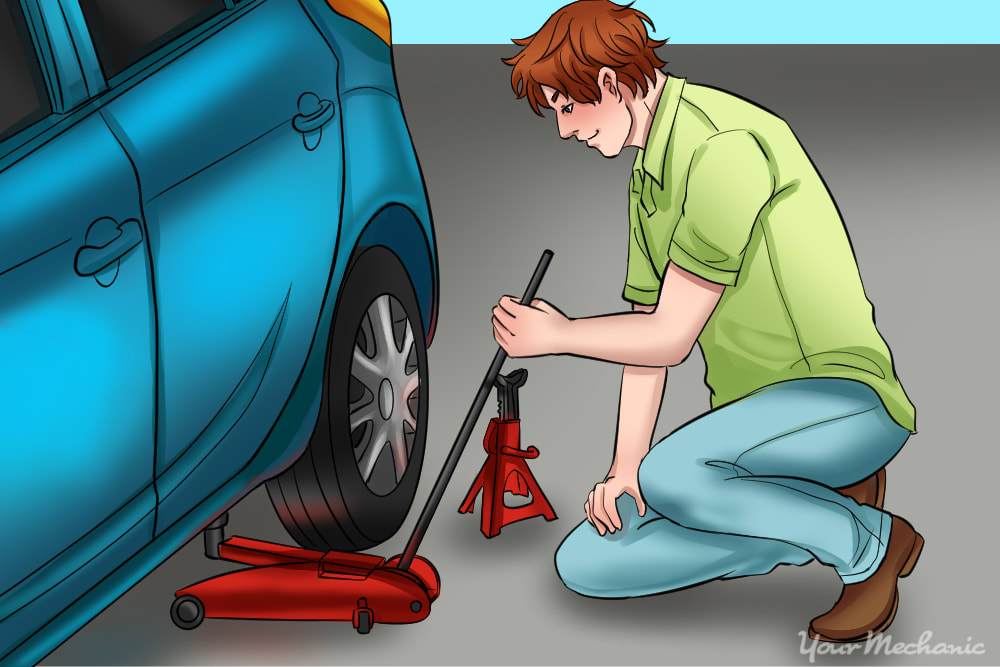

Since the invention of the modern vehicle, car owners have utilized jacks and jack stands in some shape or form to raise their vehicles in order to perform maintenance. Whether it's for removing a flat tire, or to gain access to a hard to reach part under the vehicle, people use jacks and jack stands on a daily basis. Although these tools can be very safe to use, there are a series of steps and safety regulations that must be followed to ensure anyone working underneath or around the vehicle is as safe as possible.
Below are the steps that should be followed anytime a jack and jack stands are used, regardless of the type or style of jacks utilized.
Part 1 of 1: Using jacks and jack stands
Step 1: Always refer to the vehicle's owner manual for recommended jack usage: Most car, truck, and SUV owners will only use a jack and jack stands if they are attempting to change a flat tire. Rebuilding an engine, replacing a catalytic converter, changing wheel bearings, flaring brake lines, and replacing a crankshaft seal are just some of the many jobs that require your car to be jacked up.
Before using any jack or jack stand, please verify the following information with the vehicle owner manual.
Verify the location of the jack stand supports: on every vehicle, there is a recommended location to place the jack in order to elevate the vehicle safely. On passenger cars and many SUVs, this is noted by an arrow or marking indicator usually located on the side of the vehicle. The manufacturer uses this placement for safety and leverage purposes.
Verify the maximum weight capacity of any jack and jack stands used: although most automotive manufacturers place a portable jack for use with that individual vehicle, you should always verify the maximum weight capacity for any jack and jack stands used. This can be found on the jack itself and the vehicle weight can be found on the inside of the driver door.
Step 2: Only use a jack for lifting - always use jack stands for support: The jacks and jack stands should always be used together. Although most vehicles do not come with a secondary jack stand, you should ONLY use that style of jack for replacing a flat tire. Any other applications or uses of the jack should always be accompanied by an equally sized jack stand. Another safety rule of thumb is to never go underneath a vehicle that does not have both a jack and at least one jack stand supporting the vehicle.
Step 3: Always use a jack and jack stand on a level surface: When preparing your vehicle to use a jack and jack stand, make sure to use them on a level surface. Using a jack or jack stand on a slanted or elevated surface can cause the jack stand to fall.
Step 4: Always use wood or a solid wheel chock to support front and back wheels: Before you raise the vehicle, always use a block of wood or a solid wheel chock to secure the tires. This is used as a safety measure to ensure that when you jack the vehicle up, weight is equally distributed.
Step 5: Place vehicle in Park (on automatic) or in a forward gear (manual) and set the parking brake before raising vehicle.
Step 6: Place jack in the recommended location: Make sure to center the jack and begin to raise the jack slowly to verify that it will contact the desired spot perfectly level. Once the jack touches the lift point, make sure nothing or no body parts are underneath the vehicle. Continue to raise the vehicle until the desired height is reached.
Step 7: Place jack stands in desired supporting spot: Refer to your vehicle owner manual for locations of jack stand supports.**
Step 8: Slowly lower jack until vehicle rests on jack stands: The vehicle should rest on the jack stands; not the jack itself if you are working underneath the vehicle. Slowly lower the jack until the vehicle's weight is on the jack stand. Once this occurs slowly raise the jack until it supports the vehicle; but does not continue to raise the vehicle.
Step 9: Gently rock the vehicle to ensure it is solidly on the jack and jack stands before working underneath the vehicle:
Step 10: Perform service, then raise jack, remove jack stands then lower vehicle to the ground safely: Always follow the manufacturers service manual for exact instructions on how to lower the vehicle. Remember to remove all wood blocks or any other support items after the vehicle has been lowered.



